BIPX202: Developing Social Innovation for Community Engagement
VerifiedAdded on 2023/06/13
|11
|2921
|104
Report
AI Summary
This report discusses the concept of social innovation and its application to community development, specifically focusing on Community Engagement Consulting Australia, a non-profit organization. The organization aims to provide consultancy and training services to communities in Australia, particularly aboriginals, people with disabilities, migrants, and refugees, to improve their digital literacy. The proposed social innovation involves training these communities to encourage startups and access job opportunities. The report analyzes social innovation and community engagement theory, the proposed innovation, and its ethical, environmental, and economic implications. It also addresses potential implementation challenges, including governmental regulations, cultural barriers, historical discrimination, and geographical distance. The goal is to empower marginalized communities by integrating them into the digital economy.
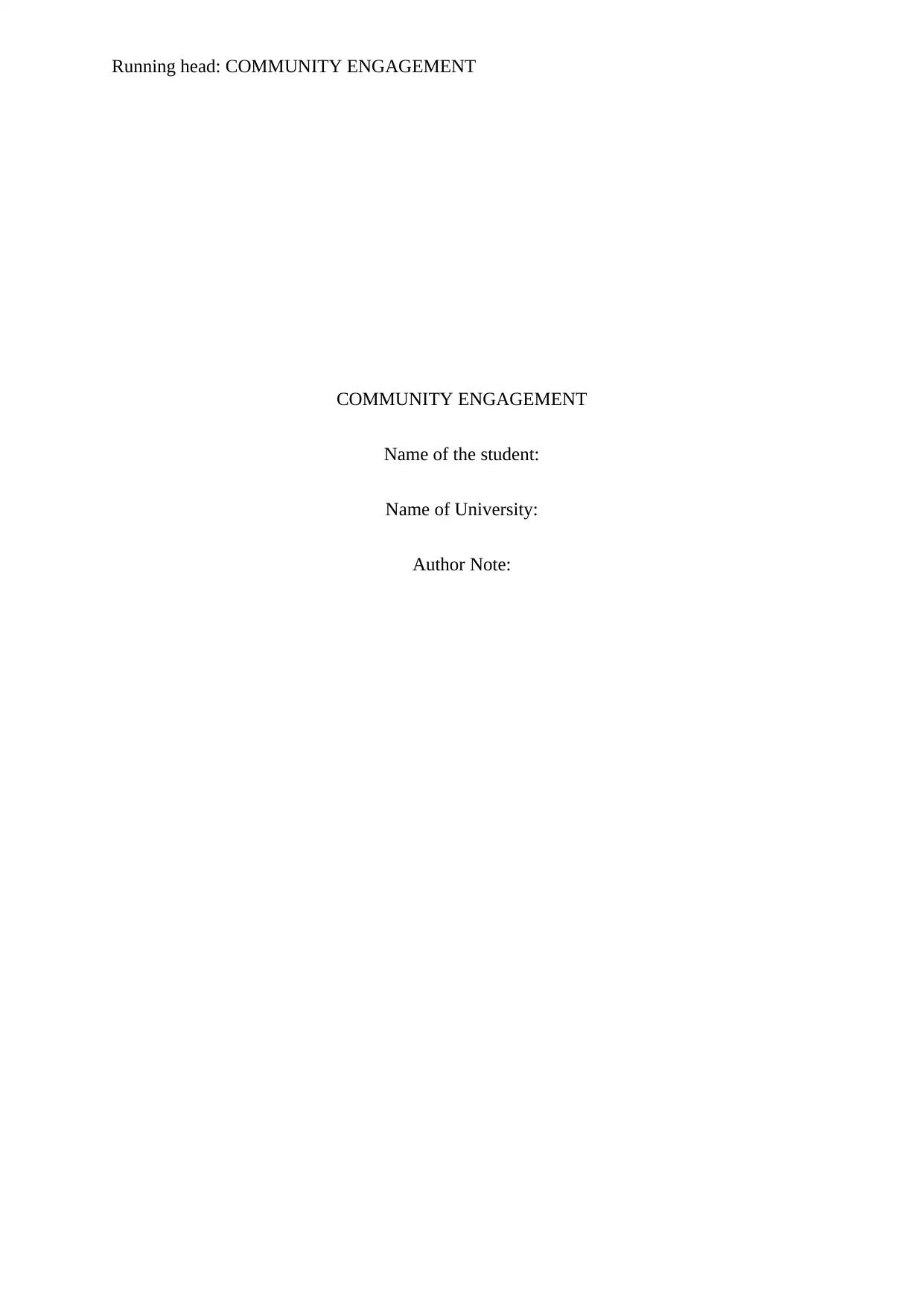
Running head: COMMUNITY ENGAGEMENT
COMMUNITY ENGAGEMENT
Name of the student:
Name of University:
Author Note:
COMMUNITY ENGAGEMENT
Name of the student:
Name of University:
Author Note:
Paraphrase This Document
Need a fresh take? Get an instant paraphrase of this document with our AI Paraphraser
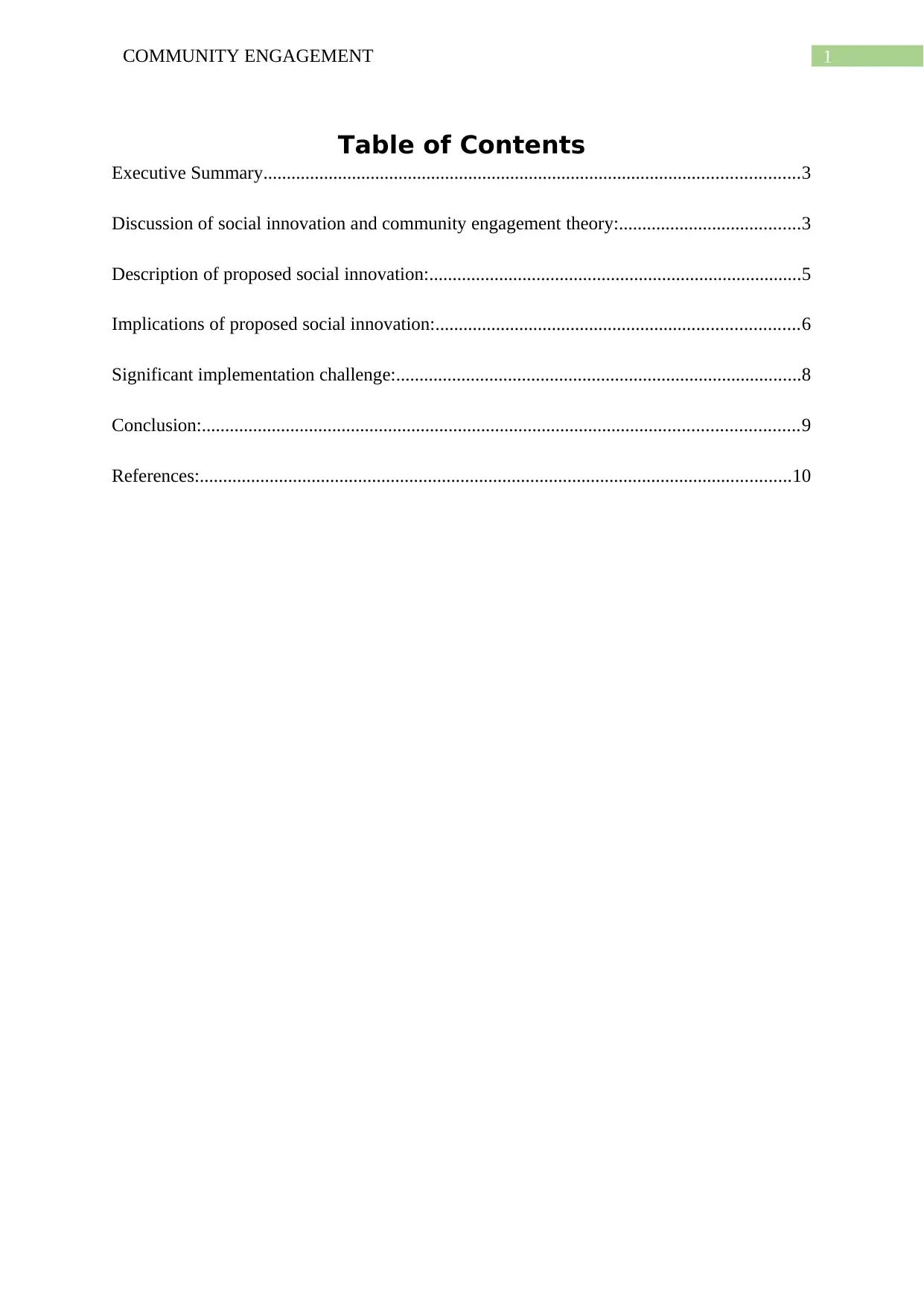
1COMMUNITY ENGAGEMENT
Table of Contents
Executive Summary...................................................................................................................3
Discussion of social innovation and community engagement theory:.......................................3
Description of proposed social innovation:................................................................................5
Implications of proposed social innovation:..............................................................................6
Significant implementation challenge:.......................................................................................8
Conclusion:................................................................................................................................9
References:...............................................................................................................................10
Table of Contents
Executive Summary...................................................................................................................3
Discussion of social innovation and community engagement theory:.......................................3
Description of proposed social innovation:................................................................................5
Implications of proposed social innovation:..............................................................................6
Significant implementation challenge:.......................................................................................8
Conclusion:................................................................................................................................9
References:...............................................................................................................................10
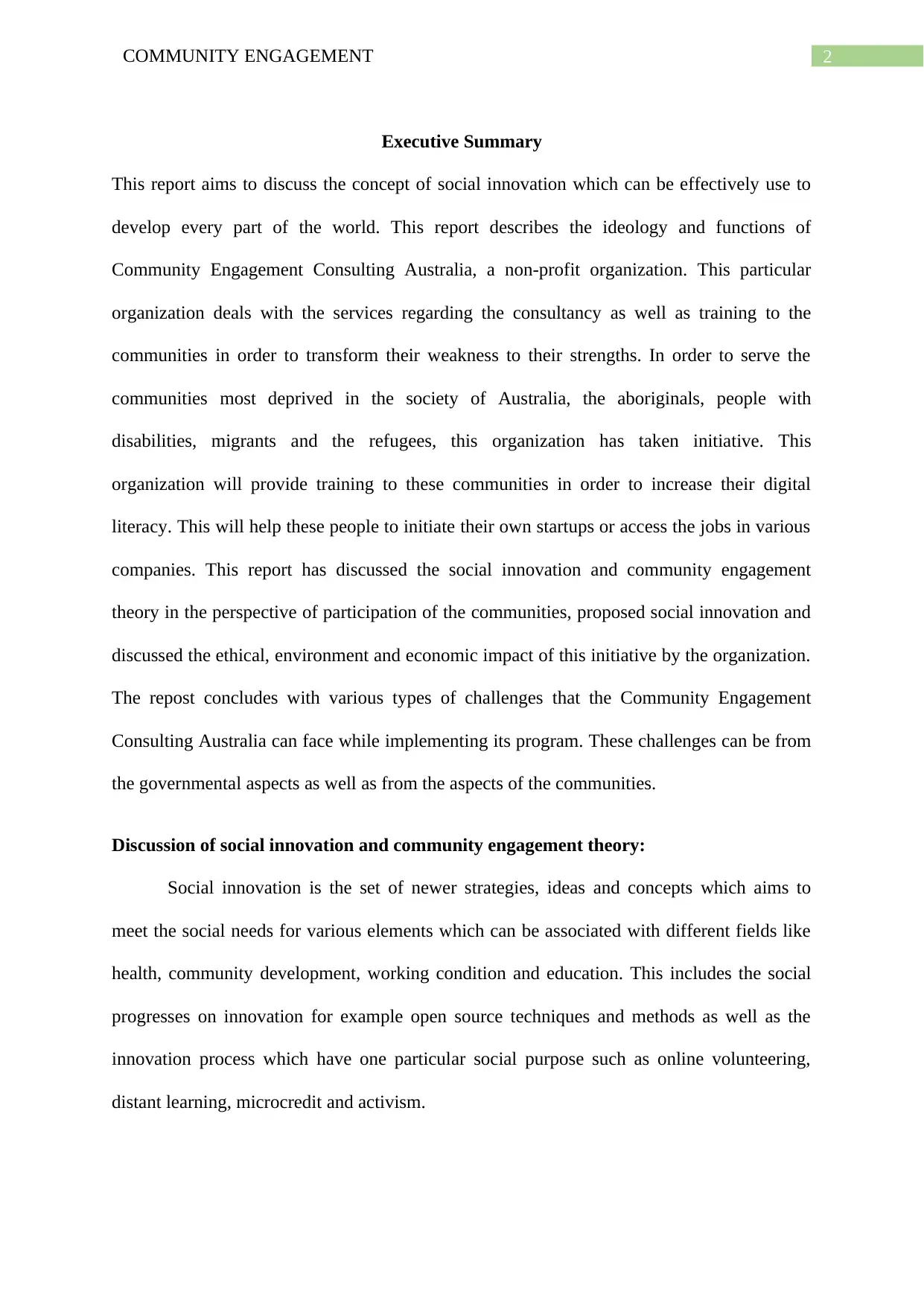
2COMMUNITY ENGAGEMENT
Executive Summary
This report aims to discuss the concept of social innovation which can be effectively use to
develop every part of the world. This report describes the ideology and functions of
Community Engagement Consulting Australia, a non-profit organization. This particular
organization deals with the services regarding the consultancy as well as training to the
communities in order to transform their weakness to their strengths. In order to serve the
communities most deprived in the society of Australia, the aboriginals, people with
disabilities, migrants and the refugees, this organization has taken initiative. This
organization will provide training to these communities in order to increase their digital
literacy. This will help these people to initiate their own startups or access the jobs in various
companies. This report has discussed the social innovation and community engagement
theory in the perspective of participation of the communities, proposed social innovation and
discussed the ethical, environment and economic impact of this initiative by the organization.
The repost concludes with various types of challenges that the Community Engagement
Consulting Australia can face while implementing its program. These challenges can be from
the governmental aspects as well as from the aspects of the communities.
Discussion of social innovation and community engagement theory:
Social innovation is the set of newer strategies, ideas and concepts which aims to
meet the social needs for various elements which can be associated with different fields like
health, community development, working condition and education. This includes the social
progresses on innovation for example open source techniques and methods as well as the
innovation process which have one particular social purpose such as online volunteering,
distant learning, microcredit and activism.
Executive Summary
This report aims to discuss the concept of social innovation which can be effectively use to
develop every part of the world. This report describes the ideology and functions of
Community Engagement Consulting Australia, a non-profit organization. This particular
organization deals with the services regarding the consultancy as well as training to the
communities in order to transform their weakness to their strengths. In order to serve the
communities most deprived in the society of Australia, the aboriginals, people with
disabilities, migrants and the refugees, this organization has taken initiative. This
organization will provide training to these communities in order to increase their digital
literacy. This will help these people to initiate their own startups or access the jobs in various
companies. This report has discussed the social innovation and community engagement
theory in the perspective of participation of the communities, proposed social innovation and
discussed the ethical, environment and economic impact of this initiative by the organization.
The repost concludes with various types of challenges that the Community Engagement
Consulting Australia can face while implementing its program. These challenges can be from
the governmental aspects as well as from the aspects of the communities.
Discussion of social innovation and community engagement theory:
Social innovation is the set of newer strategies, ideas and concepts which aims to
meet the social needs for various elements which can be associated with different fields like
health, community development, working condition and education. This includes the social
progresses on innovation for example open source techniques and methods as well as the
innovation process which have one particular social purpose such as online volunteering,
distant learning, microcredit and activism.
⊘ This is a preview!⊘
Do you want full access?
Subscribe today to unlock all pages.

Trusted by 1+ million students worldwide
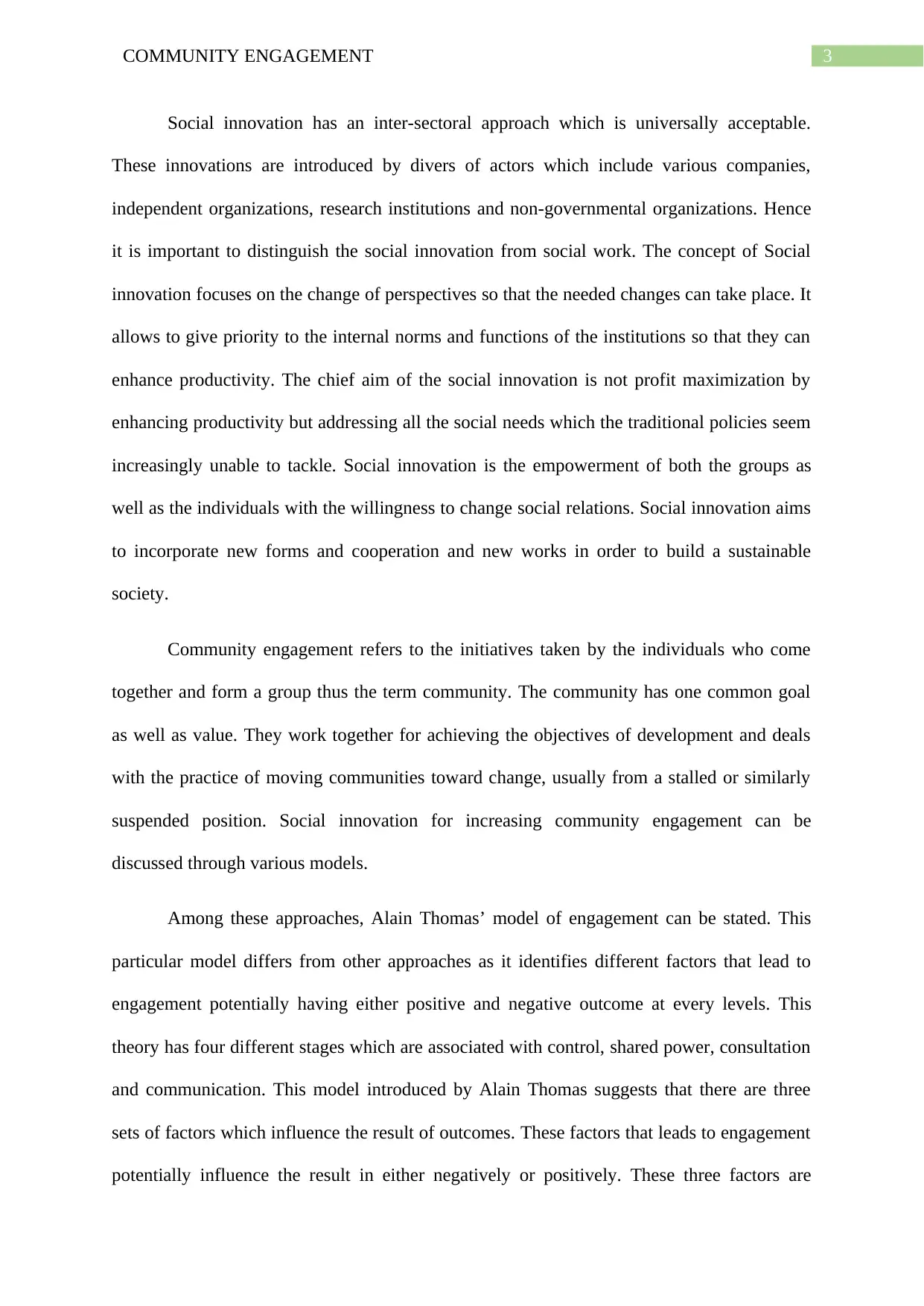
3COMMUNITY ENGAGEMENT
Social innovation has an inter-sectoral approach which is universally acceptable.
These innovations are introduced by divers of actors which include various companies,
independent organizations, research institutions and non-governmental organizations. Hence
it is important to distinguish the social innovation from social work. The concept of Social
innovation focuses on the change of perspectives so that the needed changes can take place. It
allows to give priority to the internal norms and functions of the institutions so that they can
enhance productivity. The chief aim of the social innovation is not profit maximization by
enhancing productivity but addressing all the social needs which the traditional policies seem
increasingly unable to tackle. Social innovation is the empowerment of both the groups as
well as the individuals with the willingness to change social relations. Social innovation aims
to incorporate new forms and cooperation and new works in order to build a sustainable
society.
Community engagement refers to the initiatives taken by the individuals who come
together and form a group thus the term community. The community has one common goal
as well as value. They work together for achieving the objectives of development and deals
with the practice of moving communities toward change, usually from a stalled or similarly
suspended position. Social innovation for increasing community engagement can be
discussed through various models.
Among these approaches, Alain Thomas’ model of engagement can be stated. This
particular model differs from other approaches as it identifies different factors that lead to
engagement potentially having either positive and negative outcome at every levels. This
theory has four different stages which are associated with control, shared power, consultation
and communication. This model introduced by Alain Thomas suggests that there are three
sets of factors which influence the result of outcomes. These factors that leads to engagement
potentially influence the result in either negatively or positively. These three factors are
Social innovation has an inter-sectoral approach which is universally acceptable.
These innovations are introduced by divers of actors which include various companies,
independent organizations, research institutions and non-governmental organizations. Hence
it is important to distinguish the social innovation from social work. The concept of Social
innovation focuses on the change of perspectives so that the needed changes can take place. It
allows to give priority to the internal norms and functions of the institutions so that they can
enhance productivity. The chief aim of the social innovation is not profit maximization by
enhancing productivity but addressing all the social needs which the traditional policies seem
increasingly unable to tackle. Social innovation is the empowerment of both the groups as
well as the individuals with the willingness to change social relations. Social innovation aims
to incorporate new forms and cooperation and new works in order to build a sustainable
society.
Community engagement refers to the initiatives taken by the individuals who come
together and form a group thus the term community. The community has one common goal
as well as value. They work together for achieving the objectives of development and deals
with the practice of moving communities toward change, usually from a stalled or similarly
suspended position. Social innovation for increasing community engagement can be
discussed through various models.
Among these approaches, Alain Thomas’ model of engagement can be stated. This
particular model differs from other approaches as it identifies different factors that lead to
engagement potentially having either positive and negative outcome at every levels. This
theory has four different stages which are associated with control, shared power, consultation
and communication. This model introduced by Alain Thomas suggests that there are three
sets of factors which influence the result of outcomes. These factors that leads to engagement
potentially influence the result in either negatively or positively. These three factors are
Paraphrase This Document
Need a fresh take? Get an instant paraphrase of this document with our AI Paraphraser
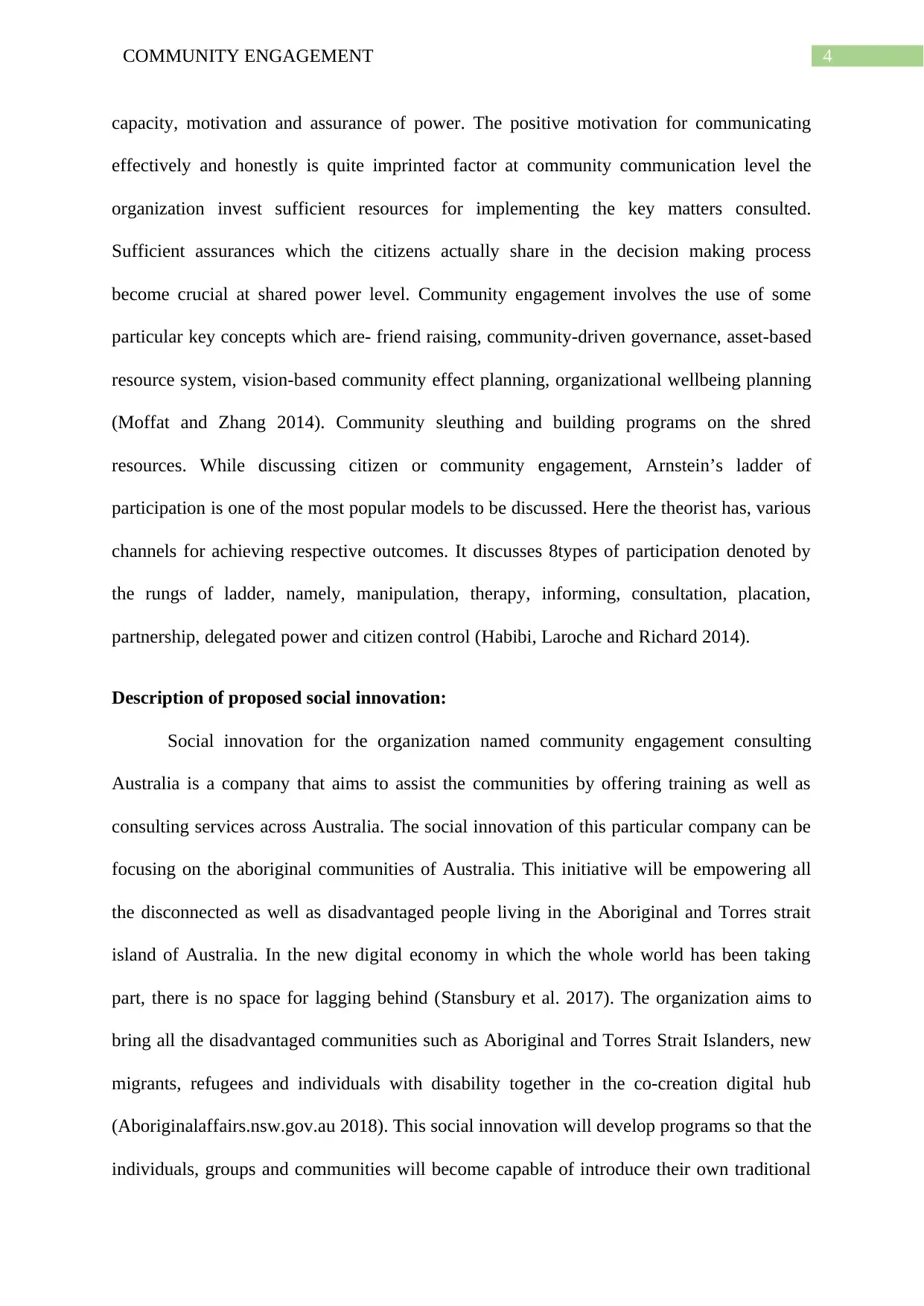
4COMMUNITY ENGAGEMENT
capacity, motivation and assurance of power. The positive motivation for communicating
effectively and honestly is quite imprinted factor at community communication level the
organization invest sufficient resources for implementing the key matters consulted.
Sufficient assurances which the citizens actually share in the decision making process
become crucial at shared power level. Community engagement involves the use of some
particular key concepts which are- friend raising, community-driven governance, asset-based
resource system, vision-based community effect planning, organizational wellbeing planning
(Moffat and Zhang 2014). Community sleuthing and building programs on the shred
resources. While discussing citizen or community engagement, Arnstein’s ladder of
participation is one of the most popular models to be discussed. Here the theorist has, various
channels for achieving respective outcomes. It discusses 8types of participation denoted by
the rungs of ladder, namely, manipulation, therapy, informing, consultation, placation,
partnership, delegated power and citizen control (Habibi, Laroche and Richard 2014).
Description of proposed social innovation:
Social innovation for the organization named community engagement consulting
Australia is a company that aims to assist the communities by offering training as well as
consulting services across Australia. The social innovation of this particular company can be
focusing on the aboriginal communities of Australia. This initiative will be empowering all
the disconnected as well as disadvantaged people living in the Aboriginal and Torres strait
island of Australia. In the new digital economy in which the whole world has been taking
part, there is no space for lagging behind (Stansbury et al. 2017). The organization aims to
bring all the disadvantaged communities such as Aboriginal and Torres Strait Islanders, new
migrants, refugees and individuals with disability together in the co-creation digital hub
(Aboriginalaffairs.nsw.gov.au 2018). This social innovation will develop programs so that the
individuals, groups and communities will become capable of introduce their own traditional
capacity, motivation and assurance of power. The positive motivation for communicating
effectively and honestly is quite imprinted factor at community communication level the
organization invest sufficient resources for implementing the key matters consulted.
Sufficient assurances which the citizens actually share in the decision making process
become crucial at shared power level. Community engagement involves the use of some
particular key concepts which are- friend raising, community-driven governance, asset-based
resource system, vision-based community effect planning, organizational wellbeing planning
(Moffat and Zhang 2014). Community sleuthing and building programs on the shred
resources. While discussing citizen or community engagement, Arnstein’s ladder of
participation is one of the most popular models to be discussed. Here the theorist has, various
channels for achieving respective outcomes. It discusses 8types of participation denoted by
the rungs of ladder, namely, manipulation, therapy, informing, consultation, placation,
partnership, delegated power and citizen control (Habibi, Laroche and Richard 2014).
Description of proposed social innovation:
Social innovation for the organization named community engagement consulting
Australia is a company that aims to assist the communities by offering training as well as
consulting services across Australia. The social innovation of this particular company can be
focusing on the aboriginal communities of Australia. This initiative will be empowering all
the disconnected as well as disadvantaged people living in the Aboriginal and Torres strait
island of Australia. In the new digital economy in which the whole world has been taking
part, there is no space for lagging behind (Stansbury et al. 2017). The organization aims to
bring all the disadvantaged communities such as Aboriginal and Torres Strait Islanders, new
migrants, refugees and individuals with disability together in the co-creation digital hub
(Aboriginalaffairs.nsw.gov.au 2018). This social innovation will develop programs so that the
individuals, groups and communities will become capable of introduce their own traditional
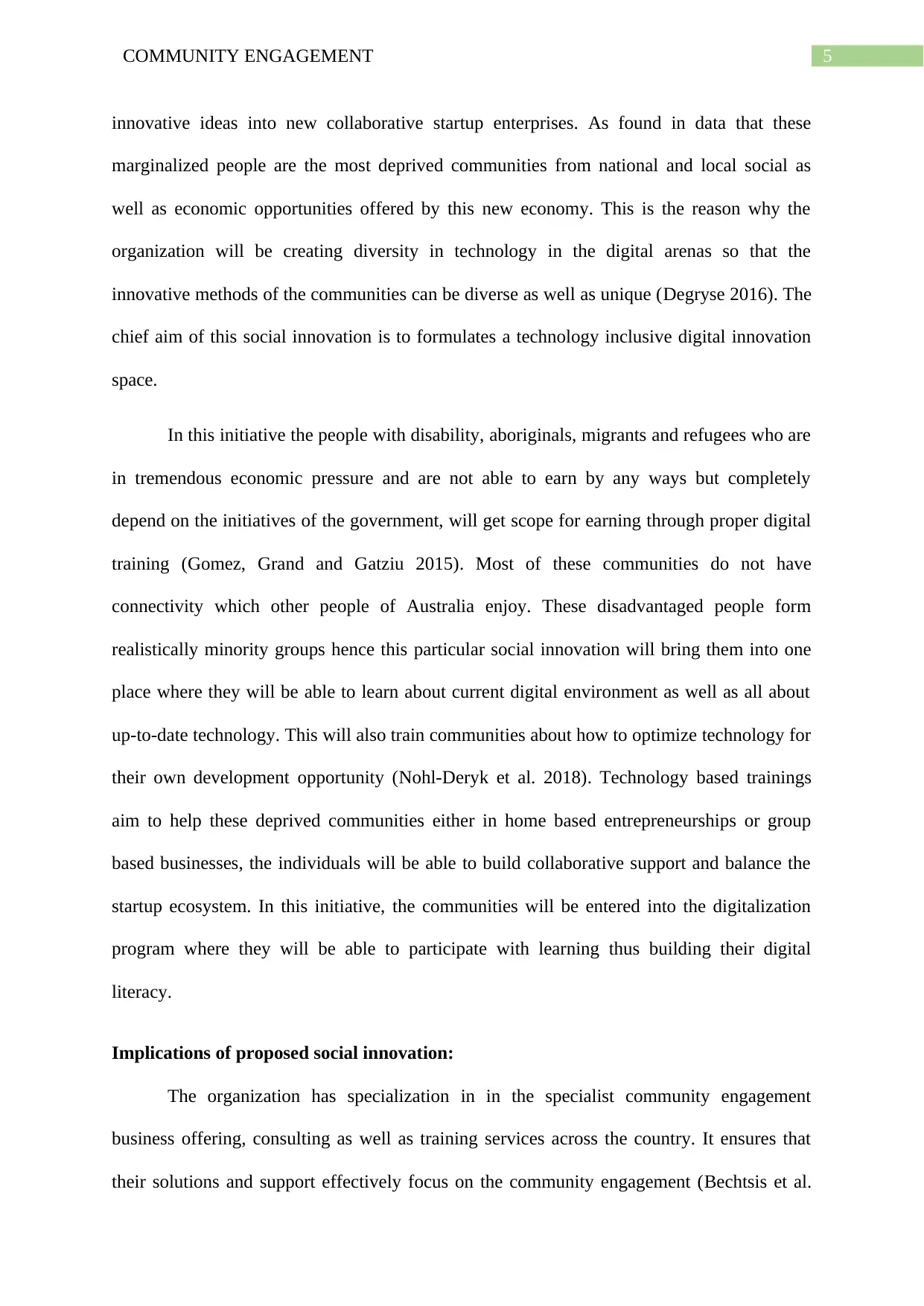
5COMMUNITY ENGAGEMENT
innovative ideas into new collaborative startup enterprises. As found in data that these
marginalized people are the most deprived communities from national and local social as
well as economic opportunities offered by this new economy. This is the reason why the
organization will be creating diversity in technology in the digital arenas so that the
innovative methods of the communities can be diverse as well as unique (Degryse 2016). The
chief aim of this social innovation is to formulates a technology inclusive digital innovation
space.
In this initiative the people with disability, aboriginals, migrants and refugees who are
in tremendous economic pressure and are not able to earn by any ways but completely
depend on the initiatives of the government, will get scope for earning through proper digital
training (Gomez, Grand and Gatziu 2015). Most of these communities do not have
connectivity which other people of Australia enjoy. These disadvantaged people form
realistically minority groups hence this particular social innovation will bring them into one
place where they will be able to learn about current digital environment as well as all about
up-to-date technology. This will also train communities about how to optimize technology for
their own development opportunity (Nohl-Deryk et al. 2018). Technology based trainings
aim to help these deprived communities either in home based entrepreneurships or group
based businesses, the individuals will be able to build collaborative support and balance the
startup ecosystem. In this initiative, the communities will be entered into the digitalization
program where they will be able to participate with learning thus building their digital
literacy.
Implications of proposed social innovation:
The organization has specialization in in the specialist community engagement
business offering, consulting as well as training services across the country. It ensures that
their solutions and support effectively focus on the community engagement (Bechtsis et al.
innovative ideas into new collaborative startup enterprises. As found in data that these
marginalized people are the most deprived communities from national and local social as
well as economic opportunities offered by this new economy. This is the reason why the
organization will be creating diversity in technology in the digital arenas so that the
innovative methods of the communities can be diverse as well as unique (Degryse 2016). The
chief aim of this social innovation is to formulates a technology inclusive digital innovation
space.
In this initiative the people with disability, aboriginals, migrants and refugees who are
in tremendous economic pressure and are not able to earn by any ways but completely
depend on the initiatives of the government, will get scope for earning through proper digital
training (Gomez, Grand and Gatziu 2015). Most of these communities do not have
connectivity which other people of Australia enjoy. These disadvantaged people form
realistically minority groups hence this particular social innovation will bring them into one
place where they will be able to learn about current digital environment as well as all about
up-to-date technology. This will also train communities about how to optimize technology for
their own development opportunity (Nohl-Deryk et al. 2018). Technology based trainings
aim to help these deprived communities either in home based entrepreneurships or group
based businesses, the individuals will be able to build collaborative support and balance the
startup ecosystem. In this initiative, the communities will be entered into the digitalization
program where they will be able to participate with learning thus building their digital
literacy.
Implications of proposed social innovation:
The organization has specialization in in the specialist community engagement
business offering, consulting as well as training services across the country. It ensures that
their solutions and support effectively focus on the community engagement (Bechtsis et al.
⊘ This is a preview!⊘
Do you want full access?
Subscribe today to unlock all pages.

Trusted by 1+ million students worldwide
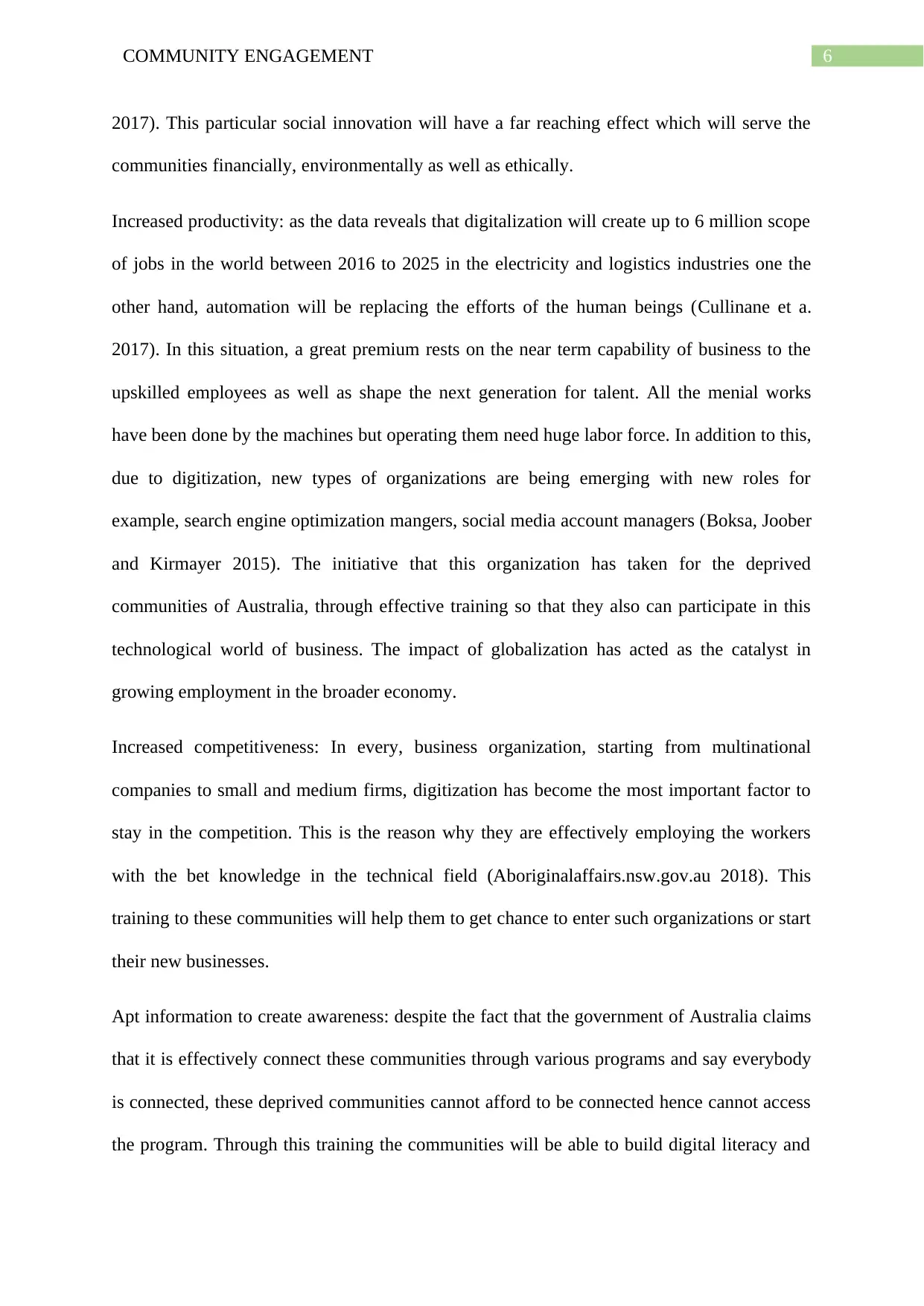
6COMMUNITY ENGAGEMENT
2017). This particular social innovation will have a far reaching effect which will serve the
communities financially, environmentally as well as ethically.
Increased productivity: as the data reveals that digitalization will create up to 6 million scope
of jobs in the world between 2016 to 2025 in the electricity and logistics industries one the
other hand, automation will be replacing the efforts of the human beings (Cullinane et a.
2017). In this situation, a great premium rests on the near term capability of business to the
upskilled employees as well as shape the next generation for talent. All the menial works
have been done by the machines but operating them need huge labor force. In addition to this,
due to digitization, new types of organizations are being emerging with new roles for
example, search engine optimization mangers, social media account managers (Boksa, Joober
and Kirmayer 2015). The initiative that this organization has taken for the deprived
communities of Australia, through effective training so that they also can participate in this
technological world of business. The impact of globalization has acted as the catalyst in
growing employment in the broader economy.
Increased competitiveness: In every, business organization, starting from multinational
companies to small and medium firms, digitization has become the most important factor to
stay in the competition. This is the reason why they are effectively employing the workers
with the bet knowledge in the technical field (Aboriginalaffairs.nsw.gov.au 2018). This
training to these communities will help them to get chance to enter such organizations or start
their new businesses.
Apt information to create awareness: despite the fact that the government of Australia claims
that it is effectively connect these communities through various programs and say everybody
is connected, these deprived communities cannot afford to be connected hence cannot access
the program. Through this training the communities will be able to build digital literacy and
2017). This particular social innovation will have a far reaching effect which will serve the
communities financially, environmentally as well as ethically.
Increased productivity: as the data reveals that digitalization will create up to 6 million scope
of jobs in the world between 2016 to 2025 in the electricity and logistics industries one the
other hand, automation will be replacing the efforts of the human beings (Cullinane et a.
2017). In this situation, a great premium rests on the near term capability of business to the
upskilled employees as well as shape the next generation for talent. All the menial works
have been done by the machines but operating them need huge labor force. In addition to this,
due to digitization, new types of organizations are being emerging with new roles for
example, search engine optimization mangers, social media account managers (Boksa, Joober
and Kirmayer 2015). The initiative that this organization has taken for the deprived
communities of Australia, through effective training so that they also can participate in this
technological world of business. The impact of globalization has acted as the catalyst in
growing employment in the broader economy.
Increased competitiveness: In every, business organization, starting from multinational
companies to small and medium firms, digitization has become the most important factor to
stay in the competition. This is the reason why they are effectively employing the workers
with the bet knowledge in the technical field (Aboriginalaffairs.nsw.gov.au 2018). This
training to these communities will help them to get chance to enter such organizations or start
their new businesses.
Apt information to create awareness: despite the fact that the government of Australia claims
that it is effectively connect these communities through various programs and say everybody
is connected, these deprived communities cannot afford to be connected hence cannot access
the program. Through this training the communities will be able to build digital literacy and
Paraphrase This Document
Need a fresh take? Get an instant paraphrase of this document with our AI Paraphraser
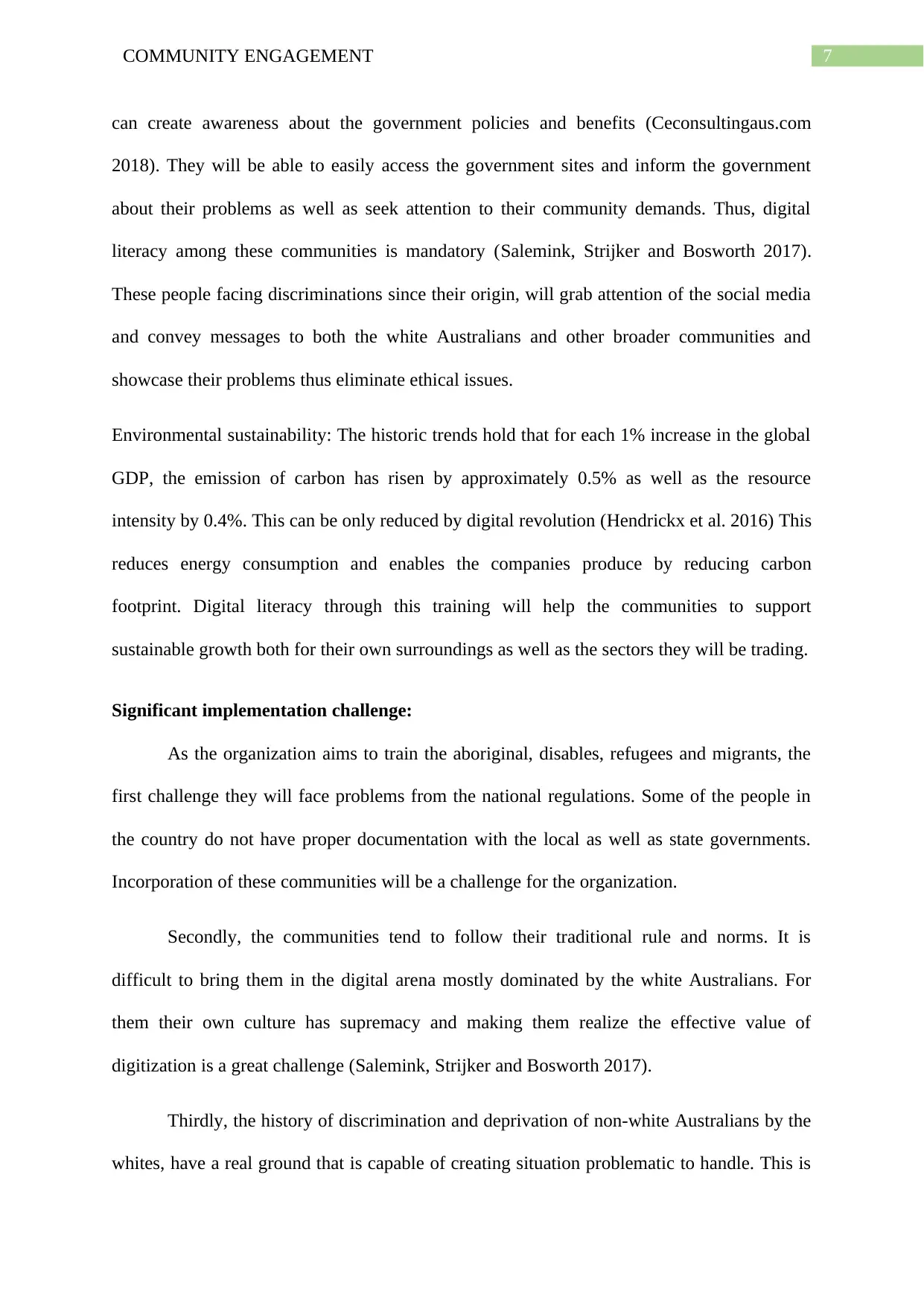
7COMMUNITY ENGAGEMENT
can create awareness about the government policies and benefits (Ceconsultingaus.com
2018). They will be able to easily access the government sites and inform the government
about their problems as well as seek attention to their community demands. Thus, digital
literacy among these communities is mandatory (Salemink, Strijker and Bosworth 2017).
These people facing discriminations since their origin, will grab attention of the social media
and convey messages to both the white Australians and other broader communities and
showcase their problems thus eliminate ethical issues.
Environmental sustainability: The historic trends hold that for each 1% increase in the global
GDP, the emission of carbon has risen by approximately 0.5% as well as the resource
intensity by 0.4%. This can be only reduced by digital revolution (Hendrickx et al. 2016) This
reduces energy consumption and enables the companies produce by reducing carbon
footprint. Digital literacy through this training will help the communities to support
sustainable growth both for their own surroundings as well as the sectors they will be trading.
Significant implementation challenge:
As the organization aims to train the aboriginal, disables, refugees and migrants, the
first challenge they will face problems from the national regulations. Some of the people in
the country do not have proper documentation with the local as well as state governments.
Incorporation of these communities will be a challenge for the organization.
Secondly, the communities tend to follow their traditional rule and norms. It is
difficult to bring them in the digital arena mostly dominated by the white Australians. For
them their own culture has supremacy and making them realize the effective value of
digitization is a great challenge (Salemink, Strijker and Bosworth 2017).
Thirdly, the history of discrimination and deprivation of non-white Australians by the
whites, have a real ground that is capable of creating situation problematic to handle. This is
can create awareness about the government policies and benefits (Ceconsultingaus.com
2018). They will be able to easily access the government sites and inform the government
about their problems as well as seek attention to their community demands. Thus, digital
literacy among these communities is mandatory (Salemink, Strijker and Bosworth 2017).
These people facing discriminations since their origin, will grab attention of the social media
and convey messages to both the white Australians and other broader communities and
showcase their problems thus eliminate ethical issues.
Environmental sustainability: The historic trends hold that for each 1% increase in the global
GDP, the emission of carbon has risen by approximately 0.5% as well as the resource
intensity by 0.4%. This can be only reduced by digital revolution (Hendrickx et al. 2016) This
reduces energy consumption and enables the companies produce by reducing carbon
footprint. Digital literacy through this training will help the communities to support
sustainable growth both for their own surroundings as well as the sectors they will be trading.
Significant implementation challenge:
As the organization aims to train the aboriginal, disables, refugees and migrants, the
first challenge they will face problems from the national regulations. Some of the people in
the country do not have proper documentation with the local as well as state governments.
Incorporation of these communities will be a challenge for the organization.
Secondly, the communities tend to follow their traditional rule and norms. It is
difficult to bring them in the digital arena mostly dominated by the white Australians. For
them their own culture has supremacy and making them realize the effective value of
digitization is a great challenge (Salemink, Strijker and Bosworth 2017).
Thirdly, the history of discrimination and deprivation of non-white Australians by the
whites, have a real ground that is capable of creating situation problematic to handle. This is
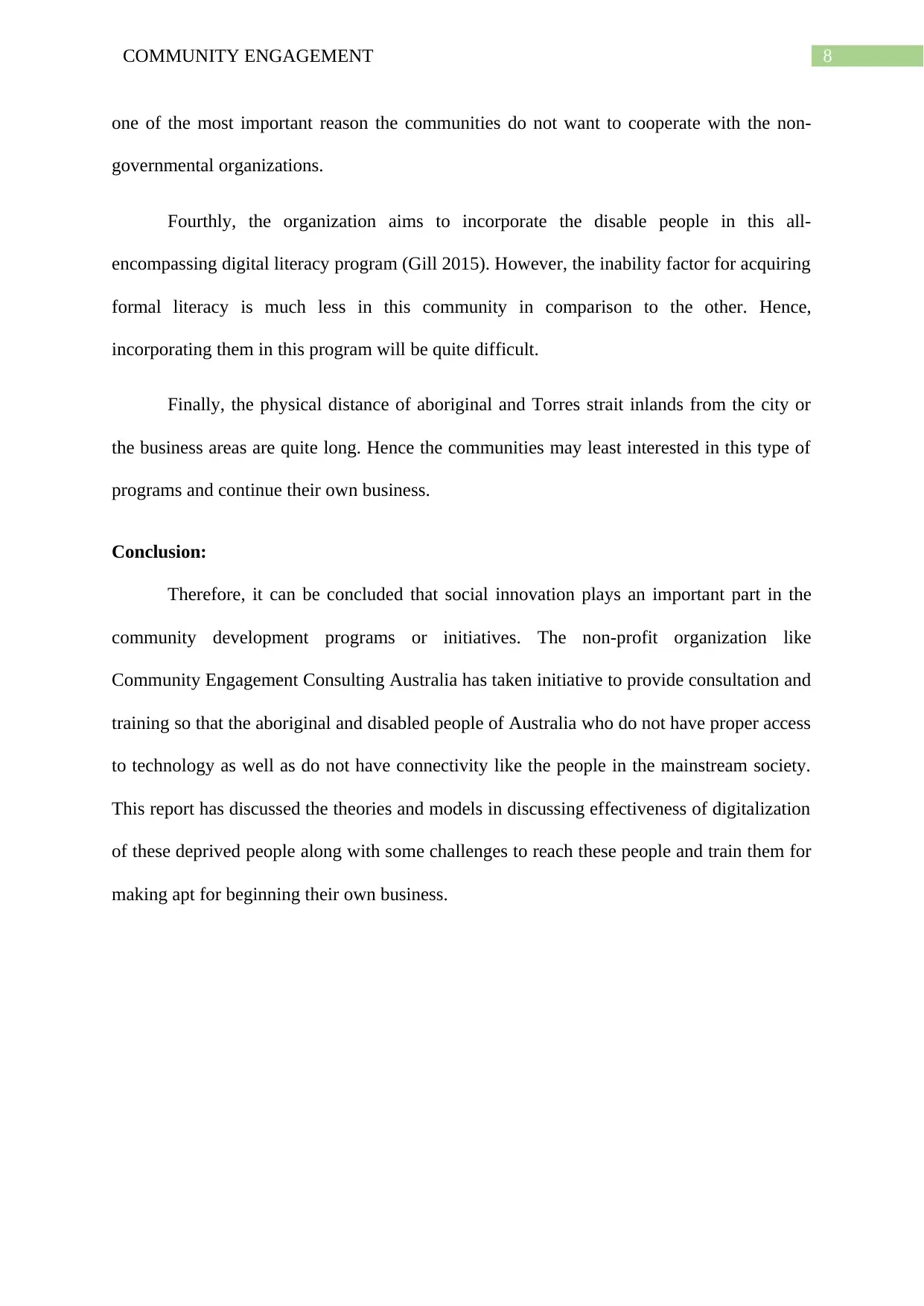
8COMMUNITY ENGAGEMENT
one of the most important reason the communities do not want to cooperate with the non-
governmental organizations.
Fourthly, the organization aims to incorporate the disable people in this all-
encompassing digital literacy program (Gill 2015). However, the inability factor for acquiring
formal literacy is much less in this community in comparison to the other. Hence,
incorporating them in this program will be quite difficult.
Finally, the physical distance of aboriginal and Torres strait inlands from the city or
the business areas are quite long. Hence the communities may least interested in this type of
programs and continue their own business.
Conclusion:
Therefore, it can be concluded that social innovation plays an important part in the
community development programs or initiatives. The non-profit organization like
Community Engagement Consulting Australia has taken initiative to provide consultation and
training so that the aboriginal and disabled people of Australia who do not have proper access
to technology as well as do not have connectivity like the people in the mainstream society.
This report has discussed the theories and models in discussing effectiveness of digitalization
of these deprived people along with some challenges to reach these people and train them for
making apt for beginning their own business.
one of the most important reason the communities do not want to cooperate with the non-
governmental organizations.
Fourthly, the organization aims to incorporate the disable people in this all-
encompassing digital literacy program (Gill 2015). However, the inability factor for acquiring
formal literacy is much less in this community in comparison to the other. Hence,
incorporating them in this program will be quite difficult.
Finally, the physical distance of aboriginal and Torres strait inlands from the city or
the business areas are quite long. Hence the communities may least interested in this type of
programs and continue their own business.
Conclusion:
Therefore, it can be concluded that social innovation plays an important part in the
community development programs or initiatives. The non-profit organization like
Community Engagement Consulting Australia has taken initiative to provide consultation and
training so that the aboriginal and disabled people of Australia who do not have proper access
to technology as well as do not have connectivity like the people in the mainstream society.
This report has discussed the theories and models in discussing effectiveness of digitalization
of these deprived people along with some challenges to reach these people and train them for
making apt for beginning their own business.
⊘ This is a preview!⊘
Do you want full access?
Subscribe today to unlock all pages.

Trusted by 1+ million students worldwide
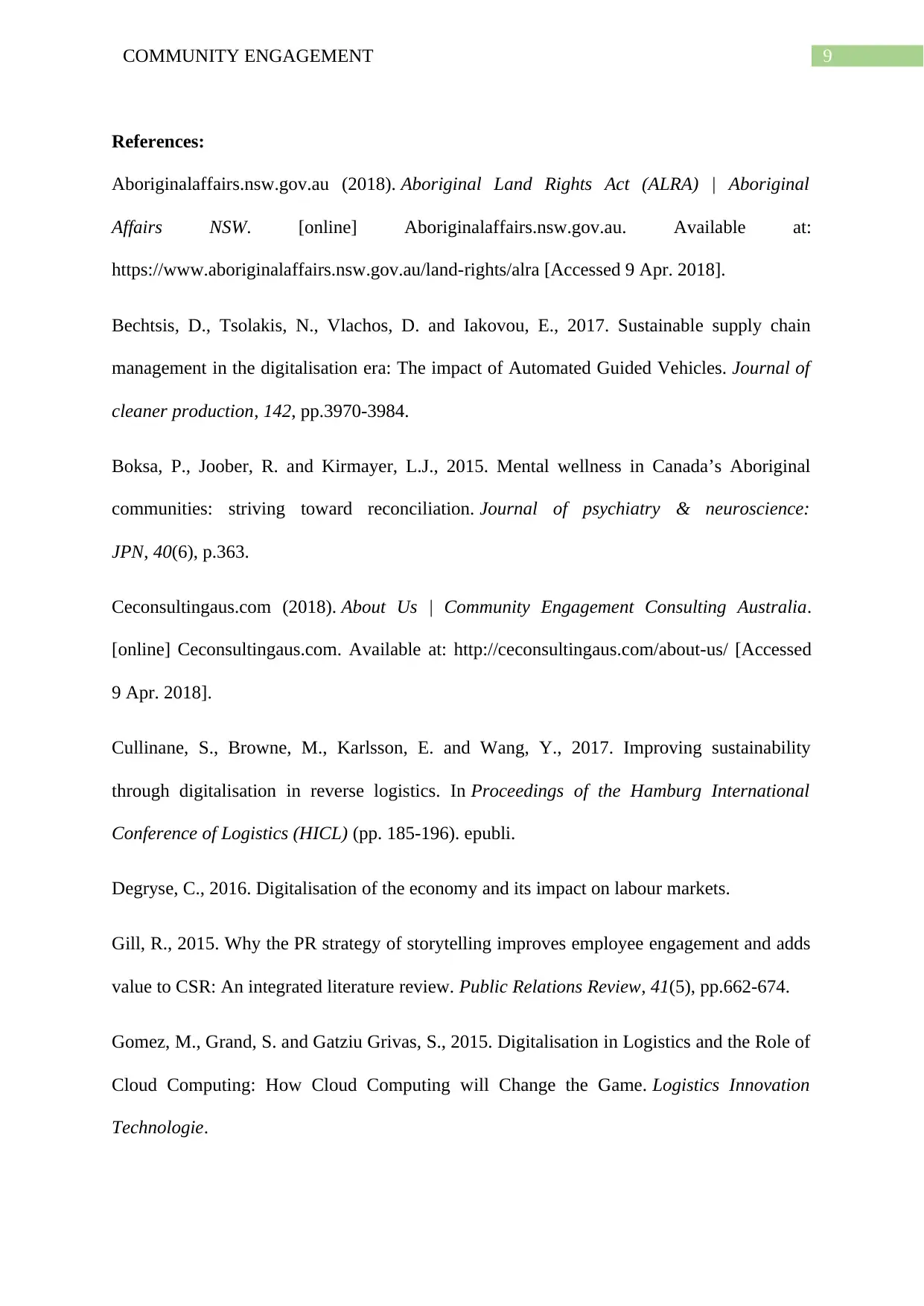
9COMMUNITY ENGAGEMENT
References:
Aboriginalaffairs.nsw.gov.au (2018). Aboriginal Land Rights Act (ALRA) | Aboriginal
Affairs NSW. [online] Aboriginalaffairs.nsw.gov.au. Available at:
https://www.aboriginalaffairs.nsw.gov.au/land-rights/alra [Accessed 9 Apr. 2018].
Bechtsis, D., Tsolakis, N., Vlachos, D. and Iakovou, E., 2017. Sustainable supply chain
management in the digitalisation era: The impact of Automated Guided Vehicles. Journal of
cleaner production, 142, pp.3970-3984.
Boksa, P., Joober, R. and Kirmayer, L.J., 2015. Mental wellness in Canada’s Aboriginal
communities: striving toward reconciliation. Journal of psychiatry & neuroscience:
JPN, 40(6), p.363.
Ceconsultingaus.com (2018). About Us | Community Engagement Consulting Australia.
[online] Ceconsultingaus.com. Available at: http://ceconsultingaus.com/about-us/ [Accessed
9 Apr. 2018].
Cullinane, S., Browne, M., Karlsson, E. and Wang, Y., 2017. Improving sustainability
through digitalisation in reverse logistics. In Proceedings of the Hamburg International
Conference of Logistics (HICL) (pp. 185-196). epubli.
Degryse, C., 2016. Digitalisation of the economy and its impact on labour markets.
Gill, R., 2015. Why the PR strategy of storytelling improves employee engagement and adds
value to CSR: An integrated literature review. Public Relations Review, 41(5), pp.662-674.
Gomez, M., Grand, S. and Gatziu Grivas, S., 2015. Digitalisation in Logistics and the Role of
Cloud Computing: How Cloud Computing will Change the Game. Logistics Innovation
Technologie.
References:
Aboriginalaffairs.nsw.gov.au (2018). Aboriginal Land Rights Act (ALRA) | Aboriginal
Affairs NSW. [online] Aboriginalaffairs.nsw.gov.au. Available at:
https://www.aboriginalaffairs.nsw.gov.au/land-rights/alra [Accessed 9 Apr. 2018].
Bechtsis, D., Tsolakis, N., Vlachos, D. and Iakovou, E., 2017. Sustainable supply chain
management in the digitalisation era: The impact of Automated Guided Vehicles. Journal of
cleaner production, 142, pp.3970-3984.
Boksa, P., Joober, R. and Kirmayer, L.J., 2015. Mental wellness in Canada’s Aboriginal
communities: striving toward reconciliation. Journal of psychiatry & neuroscience:
JPN, 40(6), p.363.
Ceconsultingaus.com (2018). About Us | Community Engagement Consulting Australia.
[online] Ceconsultingaus.com. Available at: http://ceconsultingaus.com/about-us/ [Accessed
9 Apr. 2018].
Cullinane, S., Browne, M., Karlsson, E. and Wang, Y., 2017. Improving sustainability
through digitalisation in reverse logistics. In Proceedings of the Hamburg International
Conference of Logistics (HICL) (pp. 185-196). epubli.
Degryse, C., 2016. Digitalisation of the economy and its impact on labour markets.
Gill, R., 2015. Why the PR strategy of storytelling improves employee engagement and adds
value to CSR: An integrated literature review. Public Relations Review, 41(5), pp.662-674.
Gomez, M., Grand, S. and Gatziu Grivas, S., 2015. Digitalisation in Logistics and the Role of
Cloud Computing: How Cloud Computing will Change the Game. Logistics Innovation
Technologie.
Paraphrase This Document
Need a fresh take? Get an instant paraphrase of this document with our AI Paraphraser
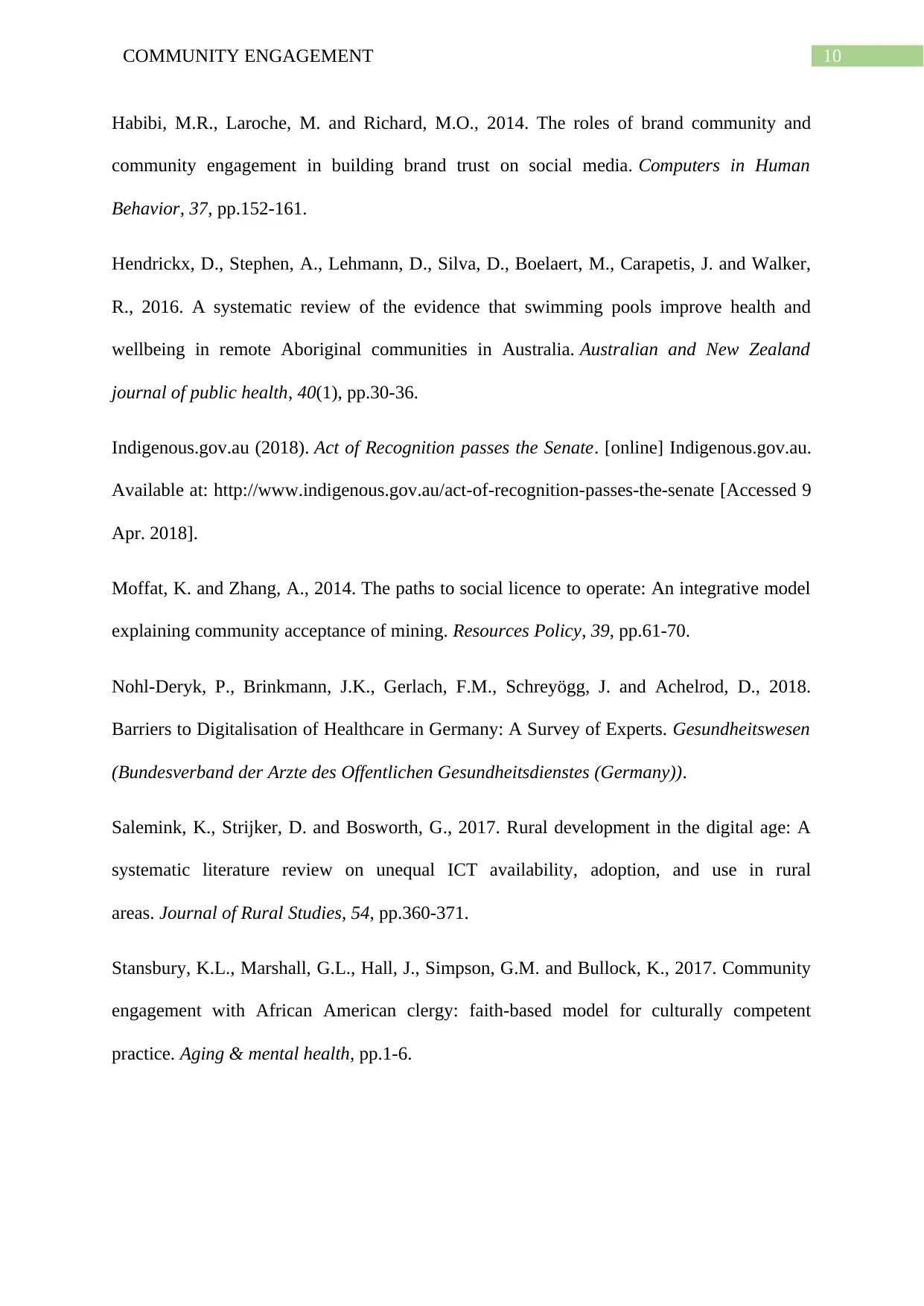
10COMMUNITY ENGAGEMENT
Habibi, M.R., Laroche, M. and Richard, M.O., 2014. The roles of brand community and
community engagement in building brand trust on social media. Computers in Human
Behavior, 37, pp.152-161.
Hendrickx, D., Stephen, A., Lehmann, D., Silva, D., Boelaert, M., Carapetis, J. and Walker,
R., 2016. A systematic review of the evidence that swimming pools improve health and
wellbeing in remote Aboriginal communities in Australia. Australian and New Zealand
journal of public health, 40(1), pp.30-36.
Indigenous.gov.au (2018). Act of Recognition passes the Senate. [online] Indigenous.gov.au.
Available at: http://www.indigenous.gov.au/act-of-recognition-passes-the-senate [Accessed 9
Apr. 2018].
Moffat, K. and Zhang, A., 2014. The paths to social licence to operate: An integrative model
explaining community acceptance of mining. Resources Policy, 39, pp.61-70.
Nohl-Deryk, P., Brinkmann, J.K., Gerlach, F.M., Schreyögg, J. and Achelrod, D., 2018.
Barriers to Digitalisation of Healthcare in Germany: A Survey of Experts. Gesundheitswesen
(Bundesverband der Arzte des Offentlichen Gesundheitsdienstes (Germany)).
Salemink, K., Strijker, D. and Bosworth, G., 2017. Rural development in the digital age: A
systematic literature review on unequal ICT availability, adoption, and use in rural
areas. Journal of Rural Studies, 54, pp.360-371.
Stansbury, K.L., Marshall, G.L., Hall, J., Simpson, G.M. and Bullock, K., 2017. Community
engagement with African American clergy: faith-based model for culturally competent
practice. Aging & mental health, pp.1-6.
Habibi, M.R., Laroche, M. and Richard, M.O., 2014. The roles of brand community and
community engagement in building brand trust on social media. Computers in Human
Behavior, 37, pp.152-161.
Hendrickx, D., Stephen, A., Lehmann, D., Silva, D., Boelaert, M., Carapetis, J. and Walker,
R., 2016. A systematic review of the evidence that swimming pools improve health and
wellbeing in remote Aboriginal communities in Australia. Australian and New Zealand
journal of public health, 40(1), pp.30-36.
Indigenous.gov.au (2018). Act of Recognition passes the Senate. [online] Indigenous.gov.au.
Available at: http://www.indigenous.gov.au/act-of-recognition-passes-the-senate [Accessed 9
Apr. 2018].
Moffat, K. and Zhang, A., 2014. The paths to social licence to operate: An integrative model
explaining community acceptance of mining. Resources Policy, 39, pp.61-70.
Nohl-Deryk, P., Brinkmann, J.K., Gerlach, F.M., Schreyögg, J. and Achelrod, D., 2018.
Barriers to Digitalisation of Healthcare in Germany: A Survey of Experts. Gesundheitswesen
(Bundesverband der Arzte des Offentlichen Gesundheitsdienstes (Germany)).
Salemink, K., Strijker, D. and Bosworth, G., 2017. Rural development in the digital age: A
systematic literature review on unequal ICT availability, adoption, and use in rural
areas. Journal of Rural Studies, 54, pp.360-371.
Stansbury, K.L., Marshall, G.L., Hall, J., Simpson, G.M. and Bullock, K., 2017. Community
engagement with African American clergy: faith-based model for culturally competent
practice. Aging & mental health, pp.1-6.
1 out of 11
Related Documents
Your All-in-One AI-Powered Toolkit for Academic Success.
+13062052269
info@desklib.com
Available 24*7 on WhatsApp / Email
![[object Object]](/_next/static/media/star-bottom.7253800d.svg)
Unlock your academic potential
Copyright © 2020–2025 A2Z Services. All Rights Reserved. Developed and managed by ZUCOL.




